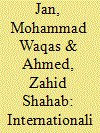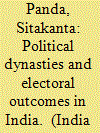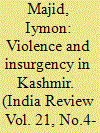|
|
|
Sort Order |
|
|
|
Items / Page
|
|
|
|
|
|
|
| Srl | Item |
| 1 |
ID:
188245


|
|
|
|
|
| Summary/Abstract |
This article shows how the international nuclear disaster in Fukushima affected the antinuclear movement in Koodankulam by using the cross-national diffusion model proposed by Kriesi, Koopmans, Duyvendak and Giugni (1995) . It examines the impact of the international disaster on the antinuclear movement and its subsequent expansion in terms of protest events and organizational trajectories. It also describes the new participants and actors in this antinuclear power issue. The research questions are addressed through archives, handbills, unpublished documents, and semi-structured interviews. I argue that diffusion of information and domestic opportunities helped the antinuclear groups erect a protest camp that offered manufactured vulnerability. This induced several meso and micro level social movement organizations and political parties to join the antinuclear movement, leading to expansion at the organizational level and the formation of coalitions. Further, the participation of newly joined social movement organizations and political parties in the mobilization helped the movement expand its protest events and led to an increase in the level of contention. The study contributes to the study of antinuclear movements and cross-national diffusion.
|
|
|
|
|
|
|
|
|
|
|
|
|
|
|
|
| 2 |
ID:
188241


|
|
|
|
|
| Summary/Abstract |
Academic scholarship on boundary making in India is disproportionately concentrated on state boundaries. Isolated attention given to other areas fails to adopt a holistic framework. The present paper traces the evolving rationales of delimiting district boundary, scheduled area boundary, and parliamentary constituency boundary. It further attempts to find a common thread to organize the boundary making principles in different arenas. Since its inception, India has embarked on a path of steady decentralization. Initially, the State reorganization commission and several constituency delimitation commissions tried to implement a pan-Indian objective. Ethnic diversity was gradually recognized in boundary making from 1970 onward, most notably in the Northeast. A drive toward ever smaller states and districts is observed under the “small is better” paradigm since 1990s. Overall, boundary making in India is intricately intertwined with political agenda and is increasingly being used for electoral expedience over achieving cardinal visions.
|
|
|
|
|
|
|
|
|
|
|
|
|
|
|
|
| 3 |
ID:
188243


|
|
|
|
|
| Summary/Abstract |
No other issue has influenced the India–Pakistan relationship more adversely than the Jammu and Kashmir dispute. To understand the discourse surrounding the dispute, and how it has evolved within the foreign policies of both countries, this research undertakes a critical discourse analysis of both countries’ official statements at the United Nations General Assembly (UNGA) between 1948 and 2020. The findings of this study are crucial to not only understanding how the two states have been internationalizing the Kashmir dispute but also what lessons can be learned from the past as both countries attempt to slowly reengage with one another. Our analysis points to the fact that both India and Pakistan’s stances on the Kashmir dispute, despite their varying phases throughout the conflict, have essentially remained the same. We argue that, despite seeming to have converged toward some form of resolution during the first decade of the twenty-first century, the current context of India–Pakistan relations presents a worsening trajectory that has not been witnessed since their last major war in 1971. In highlighting the cyclical, almost scripted nature of this debate, this paper attempts to suggest ways to break free from age-old tropes and help pave the way toward more meaningful ways to redefine the issue in light of a radically altered geo-political context.
|
|
|
|
|
|
|
|
|
|
|
|
|
|
|
|
| 4 |
ID:
188242


|
|
|
|
|
| Summary/Abstract |
This paper reads V.D. Savarkar’s last work, Six Glorious Epochs of Indian History, and advances two arguments concerning Hindutva international thought. Firstly, it foregrounds and theorizes an organicist conception of the international that is embedded in the text. Savarkar’s narrative contains a social evolutionary account of India’s historical international relations. Drawing upon a history of over two thousand years of warfare, they are extremely violent, visceral and mediated by caste and race. These aspects have not been adequately discussed within existing expositions, which emphasize culture and geopolitics. Secondly, the paper examines the Savarkarite framing of the “Akhand Bharat” problematic and the strategy for its resolution. Savarkar situates this post-partition problematic within a long and glorious record of the Hindus in successfully resisting their homeland’s internationalization. The resolution – the establishment of a subcontinental polity of the Hindus – gains within Savarkarite thought the legitimacy and force of a millenialist, affectively-charged history.
|
|
|
|
|
|
|
|
|
|
|
|
|
|
|
|
| 5 |
ID:
188240


|
|
|
|
|
| Summary/Abstract |
Political dynasties, a salient feature of the electoral politics in many electoral democracies, have critical governance implications. However, careful empirical estimates of the dynasty premium in Indian elections and explanation of their constituency-level demand side (voters) and supply side (political parties) determinants are absent. To fill this gap, we analyze the candidate-level (N = 8251) data on the 2014 Lok Sabha elections and find that a dynastic candidate is a significant 13% more likely to win and has a significant 18%–20% higher vote share than a non-dynastic candidate. This result is robust to consideration of an alternative dynasty variable as outcome, usage of alternative indicators of candidate criminality as controls, and a procedure of deducing bias due to selection on unobservables from selection on observables. In the constituency-level analyses, having a dynastic incumbent legislator in fray and dynasts’ relative wealth increases the probability of a dynastic winner and a more competitive election given the dynastic incumbent reduces it. Voter dissatisfaction, dynasts’ relative wealth, reserved constituency, and given a dynastic incumbent, higher political competition reduce voter preference for dynasts, whereas dynastic entrenchment and dynastic incumbent reduce it. The dynastic incumbent, dynasts’ relative wealth, and voter dissatisfaction significantly increase political parties’ preferences for dynasts.
|
|
|
|
|
|
|
|
|
|
|
|
|
|
|
|
| 6 |
ID:
188244


|
|
|
|
|
| Summary/Abstract |
One of the longest-surviving insurgent groups fighting the Indian state in the disputed region of Jammu and Kashmir is Hizb ul Mujahedeen. It has been linked with the Kashmiri offshoot of the Islamist organization Jama’at e Islami and has been called its armed wing. By looking at the degree of involvement of Jama’at e Islami in the Kashmir insurgency and its relationship with Hizb, the article focuses on existing organization structures. Existing structures affect the effectiveness of the insurgent group. More specifically, the paper inverts the focus from Jama’at e Islami as the political front of Hizb ul Mujahedeen and argues that the latter, in a clear understanding of the ‘micropolitics of rebellion,’ used the former to organize themselves. This article also investigates the militantization of Jama’at e Islami – a perception that its political program is inherently violent – because of its association with the insurgency.
|
|
|
|
|
|
|
|
|
|
|
|
|
|
|
|
|
|
|
|
|